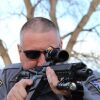During patrol rifle qualification season, it’s easy to tell who has been practicing with their rifle and who hasn’t when scoring the targets. The rusty rifle packer’s intended head shots will usually impact in the lower chin and neck due to mechanical offset and the shooter’s lack of compensation for this pesky phenomenon.
Why mechanical offset is important
By definition, mechanical offset is the distance between the sights and the bore and has an effect on the relationship between point of aim (POA) and point of impact (POI). With the common AR-15 rifle, that distance is about 2.5 inches.
Some argue that a high level of precision isn’t necessary in a close-up defensive scenario, but rarely are armed assailants as cooperative and static as range targets. Most often, the target is small and highly mobile. Also, three-dimensional felons don’t usually have generous scoring rings to compensate for marginal hits. With all that considered and the fact that we are responsible for each round fired until it reaches its final resting place, precision is mandatory.
How training can combat mechanical offset deficiencies
How do carbine toters stay sharp on the topic and how can firearms instructors help them to do so?
One way to combat this deficiency is to actually train and not just qualify once per year. Keep in mind, qualification is a test; it is not training. If our officers only shoot a few times a year during qualification, they are receiving no continuing education in firearms usage. If your department already trains regularly, kudos are in order. You’re ahead of most. Unfortunately, that isn’t a practical solution for many departments since ammunition budgets aren’t generally decided by the lowly firearms instructor or even the rangemaster.
That said, if a department requires two qualifications or even one practice round and one qualification round per year, training ammunition allotments can be split into two sessions several weeks or months apart. Also, departments can offer voluntary sessions where officers are allowed to participate in drills with their own ammunition. This costs the organization nothing more than targets and range maintenance. Adding a few rounds of training to each qualification can also help. I always end my carbine practice sessions with five slow fire rounds at three yards on a one-inch circle. That really cements the relationship between POA/POI between practice sessions. That exercise costs only a few more minutes and a fraction more ammunition and could easily be squeezed between qualifications.
Include firearms refreshers during roll call training
Not all training must be live fire, though. Continuing education is required for all sworn officers anyway. Why not make a firearms refresher course on this or other gun-related topics like trigger-finger discipline part of that classroom training? Most departments already conduct roll call/muster training at the beginning of the shift. Firearms instructors could put together a quick slide show or video that demonstrates the correct sight picture for closer distances and document who attends the training.
Visual training aids like the photograph with this article can be helpful in reminding officers about mechanical offset when they’re not at the range. They can be displayed at the range, briefing room or even in the break room. There would only be a one-time cost of printing the posters.
Initial police officer training is key
Of course, the most effective way to stop a problem is to attack it before begins. An officer’s initial training sets the tone for his or her entire career. Prior to live-fire training, have the student measure the bore to sight plane and record it in his or her notes. Early in the range portion of the class, have the student aim directly at a small circle on a target at about two or three yards. Have them fire a few rounds and measure the distance between the target and the point of impact. Then, they will fire at the same circle while compensating for mechanical offset. Have the student record the distance between POA and POI in their notes. They can even keep the target for future reference.
The above are just some examples. With a little imagination, officers and instructors can come up with inexpensive and efficient ways to combat the negative effects of mechanical offset and improve any of the myriad skills and knowledge for which we are responsible.


